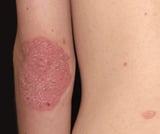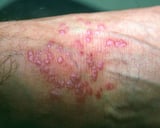What Is Onychomycosis Of The Nail
Onychomycosis is fungal infection of the nail plate, boom bed, or both. The nails typically are deformed and discolored white or xanthous. Diagnosis is by advent, wet mount, civilisation, polymerase concatenation reaction, or a combination. Handling, when indicated, is with oral terbinafine or itraconazole.
About 10% (range 2 to 14%) of the population has onychomycosis.
Risk factors for onychomycosis include
-
Older age
-
Male person sex
-
Exposure to someone with tinea pedis or onychomycosis (eg, a family member or through public bathing)
-
Immunocompromise
Symptoms and Signs
Nails have asymptomatic patches of white or yellowish discoloration and deformity. There are three common characteristic patterns:
-
Proximal subungual: A course that starts proximally and is a mark of immunosuppression.
-
White superficial: A chalky white scale slowly spreads beneath the smash surface.
-
Clinical evaluation
-
Potassium hydroxide wet mount examination
-
Culture or polymerase concatenation reaction (PCR)
-
Histopathologic test of periodic acid-Schiff (PAS)–stained boom clippings and subungual debris
(See also an update on the current approaches to diagnosis and treatment of onychomycosis.)
Differentiation from psoriasis Psoriasis Psoriasis is an inflammatory disease that manifests most normally besides-circumscribed, erythematous papules and plaques covered with silvery scales. Multiple factors contribute, including... read more  or lichen planus Lichen Planus Lichen planus is a recurrent, pruritic, inflammatory eruption characterized by small, discrete, polygonal, apartment-topped, violaceous papules that may coalesce into rough scaly plaques, often accompanied... read more than
or lichen planus Lichen Planus Lichen planus is a recurrent, pruritic, inflammatory eruption characterized by small, discrete, polygonal, apartment-topped, violaceous papules that may coalesce into rough scaly plaques, often accompanied... read more than  is of import because the therapies differ, so diagnosis is typically confirmed by microscopic test and, unless microscopic findings are conclusive, culture of scrapings or PCR of clippings. Scrapings are taken from the near proximal position that tin can exist accessed on the afflicted nail and are examined for hyphae on potassium hydroxide wet mountain and cultured. Although more expensive, PCR has get a more common technique to confirm the diagnosis of onychomycosis, especially if cultures are negative or a definitive diagnosis is required (one Diagnosis references Onychomycosis is fungal infection of the nail plate, smash bed, or both. The nails typically are deformed and discolored white or xanthous. Diagnosis is by appearance, wet mount, civilisation, polymerase... read more than
is of import because the therapies differ, so diagnosis is typically confirmed by microscopic test and, unless microscopic findings are conclusive, culture of scrapings or PCR of clippings. Scrapings are taken from the near proximal position that tin can exist accessed on the afflicted nail and are examined for hyphae on potassium hydroxide wet mountain and cultured. Although more expensive, PCR has get a more common technique to confirm the diagnosis of onychomycosis, especially if cultures are negative or a definitive diagnosis is required (one Diagnosis references Onychomycosis is fungal infection of the nail plate, smash bed, or both. The nails typically are deformed and discolored white or xanthous. Diagnosis is by appearance, wet mount, civilisation, polymerase... read more than  , 2 Diagnosis references Onychomycosis is fungal infection of the nail plate, nail bed, or both. The nails typically are plain-featured and discolored white or yellow. Diagnosis is by appearance, moisture mount, civilisation, polymerase... read more
, 2 Diagnosis references Onychomycosis is fungal infection of the nail plate, nail bed, or both. The nails typically are plain-featured and discolored white or yellow. Diagnosis is by appearance, moisture mount, civilisation, polymerase... read more  , iii Diagnosis references Onychomycosis is fungal infection of the blast plate, nail bed, or both. The nails typically are deformed and discolored white or xanthous. Diagnosis is past appearance, wet mount, civilization, polymerase... read more than
, iii Diagnosis references Onychomycosis is fungal infection of the blast plate, nail bed, or both. The nails typically are deformed and discolored white or xanthous. Diagnosis is past appearance, wet mount, civilization, polymerase... read more than  ). Histopathologic examination of PAS–stained nail clippings and subungual droppings may also be helpful.
). Histopathologic examination of PAS–stained nail clippings and subungual droppings may also be helpful.
Obtaining an acceptable sample of nail for civilization tin be difficult because the distal subungual debris, which is easy to sample, often does not contain living mucus. Therefore, removing the distal portion of the nail with clippers before sampling or using a small curette to accomplish more proximally beneath the nail increases the yield.
-
1. Joyce A, Gupta AK, Koenig L, et al: Fungal Diversity and Onychomycosis: An analysis of 8,816 toenail samples using quantitative PCR and next-generation sequencing. J Am Podiatr Med Assoc 109(ane):57–63, 2019. doi: 10.7547/17-070
-
2. Haghani I, Shams-Ghahfarokhi 1000, Dalimi Asl A, et al: Molecular identification and antifungal susceptibility of clinical fungal isolates from onychomycosis (uncommon and emerging species). Mycoses 62(2):128–143, 2019. doi: x.1111/myc.12854
-
3. Gupta AK, Mays RR, Versteeg SG, et al: Update on current approaches to diagnosis and treatment of onychomycosis. Skillful Rev Anti Infect Ther 16(12):929–938, 2018. doi: ten.1080/14787210.2018.1544891
-
Selective use of oral terbinafine or itraconazole
-
Occasional use of topical treatments (eg, efinaconazole, tavaborole, ciclopirox 8%, amorolfine)
Onychomycosis is non always treated because many cases are asymptomatic or balmy and unlikely to crusade complications, and the oral drugs that are the most constructive treatments can potentially crusade hepatotoxicity and serious drug interactions. Some proposed indications for treatment include the following:
-
Presence of bothersome symptoms
-
Psychosocial bear on
-
Desire for cosmetic comeback (controversial)
Treatment of onychomycosis is typically oral terbinafine or itraconazole. Terbinafine 250 mg once a day for 12 weeks (half-dozen weeks for fingernail) or pulse therapy with 250 mg one time a day for i week a calendar month until the smash is clear achieves a cure rate of 75 to lxxx% and itraconazole 200 mg 2 times a twenty-four hour period 1 week a month for three months achieves a cure rate of 40 to fifty%, but the overall recurrence rate is estimated to be equally high as 10 to 50%. Information technology is not entirely necessary to treat until all abnormal boom is gone because these drugs remain spring to the smash plate and proceed to be effective later oral administration has ceased; however, risk of recurrence may be college in such cases. The affected nail volition not revert to normal, but newly growing smash volition appear normal. Fluconazole may besides exist an pick.
The newer topical agents efinaconazole and tavaborole can penetrate the smash plate and are more effective than older topical agents.
Investigative treatments include new delivery systems for terbinafine. Topical antifungal nail lacquer containing efinaconazole 10%, ciclopirox 8%, or amorolfine 5% (not available in the US) is occasionally effective as primary treatment (cure rate of near 30%) and can improve cure rate when used as an adjunct with oral drugs, particularly in resistant infections.
To limit relapse, the patient should trim nails short, dry feet after bathing, wear absorbent socks, and use antifungal pes pulverization. Old shoes may harbor a high density of spores and, if possible, should not be worn.
-
Onychomycosis is highly prevalent, particularly amid older men and patients with compromised distal circulation, blast dystrophies, and/or tinea pedis.
-
Suspect the diagnosis based on appearance and the design of smash interest and confirm it by microscopy and civilisation or PCR.
-
Handling is warranted only if onychomycosis causes complications or troublesome symptoms.
-
If handling is warranted, consider terbinafine (the most constructive treatment) and measures to preclude recurrence (eg, limiting moisture, discarding old shoes, trimming nails short).
The following is an English-language resource that may be useful. Please note that THE MANUAL is not responsible for the content of this resources.

shared.CopyrightLabel © 2022 Merck & Co., Inc., Rahway, NJ, Us and its affiliates. All rights reserved.
Source: https://www.msdmanuals.com/professional/dermatologic-disorders/nail-disorders/onychomycosis
Posted by: stanleywheir1963.blogspot.com

0 Response to "What Is Onychomycosis Of The Nail"
Post a Comment